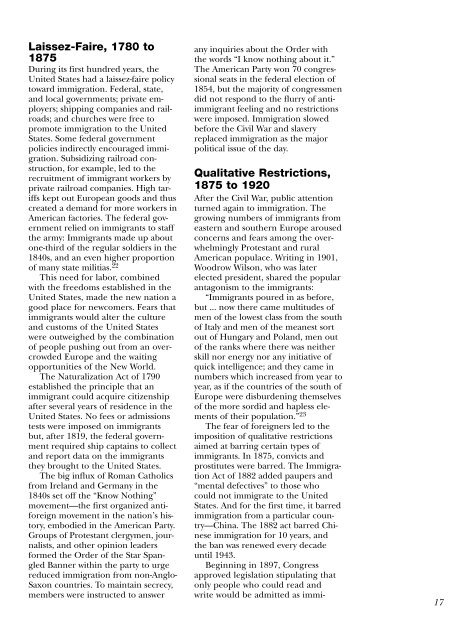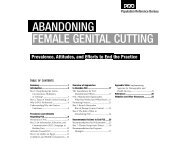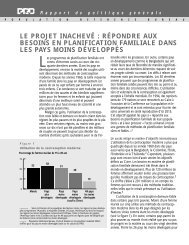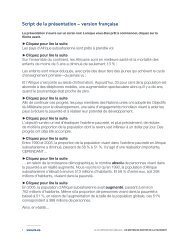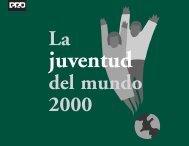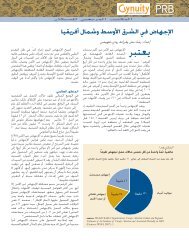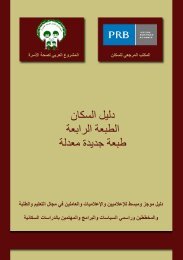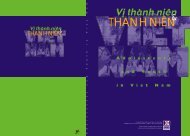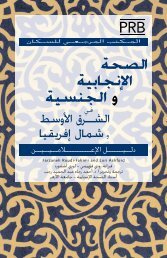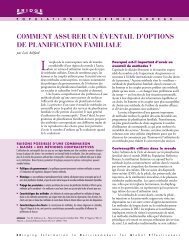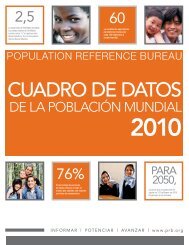Immigration Shaping America - Population Reference Bureau
Immigration Shaping America - Population Reference Bureau
Immigration Shaping America - Population Reference Bureau
Create successful ePaper yourself
Turn your PDF publications into a flip-book with our unique Google optimized e-Paper software.
Laissez-Faire, 1780 to<br />
1875<br />
During its first hundred years, the<br />
United States had a laissez-faire policy<br />
toward immigration. Federal, state,<br />
and local governments; private employers;<br />
shipping companies and railroads;<br />
and churches were free to<br />
promote immigration to the United<br />
States. Some federal government<br />
policies indirectly encouraged immigration.<br />
Subsidizing railroad construction,<br />
for example, led to the<br />
recruitment of immigrant workers by<br />
private railroad companies. High tariffs<br />
kept out European goods and thus<br />
created a demand for more workers in<br />
<strong>America</strong>n factories. The federal government<br />
relied on immigrants to staff<br />
the army: Immigrants made up about<br />
one-third of the regular soldiers in the<br />
1840s, and an even higher proportion<br />
of many state militias. 22<br />
This need for labor, combined<br />
with the freedoms established in the<br />
United States, made the new nation a<br />
good place for newcomers. Fears that<br />
immigrants would alter the culture<br />
and customs of the United States<br />
were outweighed by the combination<br />
of people pushing out from an overcrowded<br />
Europe and the waiting<br />
opportunities of the New World.<br />
The Naturalization Act of 1790<br />
established the principle that an<br />
immigrant could acquire citizenship<br />
after several years of residence in the<br />
United States. No fees or admissions<br />
tests were imposed on immigrants<br />
but, after 1819, the federal government<br />
required ship captains to collect<br />
and report data on the immigrants<br />
they brought to the United States.<br />
The big influx of Roman Catholics<br />
from Ireland and Germany in the<br />
1840s set off the “Know Nothing”<br />
movement—the first organized antiforeign<br />
movement in the nation’s history,<br />
embodied in the <strong>America</strong>n Party.<br />
Groups of Protestant clergymen, journalists,<br />
and other opinion leaders<br />
formed the Order of the Star Spangled<br />
Banner within the party to urge<br />
reduced immigration from non-Anglo-<br />
Saxon countries. To maintain secrecy,<br />
members were instructed to answer<br />
any inquiries about the Order with<br />
the words “I know nothing about it.”<br />
The <strong>America</strong>n Party won 70 congressional<br />
seats in the federal election of<br />
1854, but the majority of congressmen<br />
did not respond to the flurry of antiimmigrant<br />
feeling and no restrictions<br />
were imposed. <strong>Immigration</strong> slowed<br />
before the Civil War and slavery<br />
replaced immigration as the major<br />
political issue of the day.<br />
Qualitative Restrictions,<br />
1875 to 1920<br />
After the Civil War, public attention<br />
turned again to immigration. The<br />
growing numbers of immigrants from<br />
eastern and southern Europe aroused<br />
concerns and fears among the overwhelmingly<br />
Protestant and rural<br />
<strong>America</strong>n populace. Writing in 1901,<br />
Woodrow Wilson, who was later<br />
elected president, shared the popular<br />
antagonism to the immigrants:<br />
“Immigrants poured in as before,<br />
but ... now there came multitudes of<br />
men of the lowest class from the south<br />
of Italy and men of the meanest sort<br />
out of Hungary and Poland, men out<br />
of the ranks where there was neither<br />
skill nor energy nor any initiative of<br />
quick intelligence; and they came in<br />
numbers which increased from year to<br />
year, as if the countries of the south of<br />
Europe were disburdening themselves<br />
of the more sordid and hapless elements<br />
of their population.” 23<br />
The fear of foreigners led to the<br />
imposition of qualitative restrictions<br />
aimed at barring certain types of<br />
immigrants. In 1875, convicts and<br />
prostitutes were barred. The <strong>Immigration</strong><br />
Act of 1882 added paupers and<br />
“mental defectives” to those who<br />
could not immigrate to the United<br />
States. And for the first time, it barred<br />
immigration from a particular country—China.<br />
The 1882 act barred Chinese<br />
immigration for 10 years, and<br />
the ban was renewed every decade<br />
until 1943.<br />
Beginning in 1897, Congress<br />
approved legislation stipulating that<br />
only people who could read and<br />
write would be admitted as immi-<br />
17


